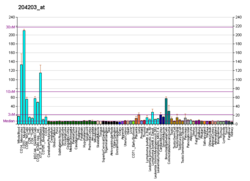CCAAT/enhancer-binding protein gamma (C/EBPγ) is a protein that in humans is encoded by the CEBPG gene.[5][6] This gene has no introns.
The C/EBP family of transcription factors regulates viral and cellular CCAAT/enhancer element-mediated transcription. C/EBP proteins contain the bZIP region, which is characterized by two motifs in the C-terminal half of the protein: a basic region involved in DNA binding and a leucine zipper motif involved in dimerization. The C/EBP family consist of several related proteins, C/EBPα, C/EBPβ, C/EBPγ, C/EBPδ, C/EBPζ, and C/EBPε, that form homodimers and that form heterodimers with each other. CCAAT/enhancer binding protein gamma may cooperate with Fos to bind the positive regulatory element-I (PRE-I) enhancer elements.[6][7]
C/EBPγ forms heterodimer with ATF4 for transcriptional activation of target genes in autophagy specifically to amino acid starvation.[8]
C/EBPγ along with its regulator, the trauma-induced transcription factor EGR1, plays an important role in the development of chronic pain and mechanical hypersensitivity after some types of injury or surgery.[9][10]
YouTube Encyclopedic
-
1/2Views:3711 448
-
Encerramento Escola Pingo de Gente 2019
-
Dr. Jake Lusis, Metabolic Disease Prevention
Transcription
References
- ^ a b c GRCh38: Ensembl release 89: ENSG00000153879 - Ensembl, May 2017
- ^ a b c GRCm38: Ensembl release 89: ENSMUSG00000056216 - Ensembl, May 2017
- ^ "Human PubMed Reference:". National Center for Biotechnology Information, U.S. National Library of Medicine.
- ^ "Mouse PubMed Reference:". National Center for Biotechnology Information, U.S. National Library of Medicine.
- ^ Williams SC, Cantwell CA, Johnson PF (Oct 1991). "A family of C/EBP-related proteins capable of forming covalently linked leucine zipper dimers in vitro". Genes Dev. 5 (9): 1553–67. doi:10.1101/gad.5.9.1553. PMID 1884998.
- ^ a b "Entrez Gene: CEBPG CCAAT/enhancer binding protein (C/EBP), gamma".
- ^ Davydov, Ilia V.; Bohmann, Dirk; Krammer, Peter H.; Li-Weber, Min (1995). "Cloning of the cDNA encoding human C/EBPγ, a protein binding to the PRE-I enhancer element of the human interleukin-4 promoter". Gene. 161 (2): 271–275. doi:10.1016/0378-1119(95)00271-7. PMID 7665092.
- ^ Kim, Dongha; Kim, Junil; Yu, Young Suk; Kim, Yong Ryoul; Baek, Sung Hee; Won, Kyoung-Jae (Jul 2022). "Systemic approaches using single cell transcriptome reveal that C/EBPγ regulates autophagy under amino acid starved condition". Nucleic Acids Research. 50 (13): 7298–7309. doi:10.1093/nar/gkac593. PMC 9303372. PMID 35801910.
- ^ Mamet, Julien; Klukinov, Michael; Yaksh, Tony L.; Malkmus, Shelle A.; Williams, Samantha; Harris, Scott; Manning, Donald C.; Taylor, Bradley K.; Donahue, Renee R.; Porreca, Frank; Xie, Jennifer Y.; Oyarzo, Janice; Brennan, Timothy J.; Subieta, Alberto; Schmidt, William K.; Yeomans, David C. (2014). "Single intrathecal administration of the transcription factor decoy AYX1 prevents acute and chronic pain after incisional, inflammatory, or neuropathic injury". Pain. 155 (2): 322–333. doi:10.1016/j.pain.2013.10.015. PMID 24145208. S2CID 29286007.
- ^ Stephens, Kimberly E.; Moore, Cedric; Vinson, David A.; White, Bryan E.; Renfro, Zachary; Zhou, Weiqiang; Ji, Zhicheng; Ji, Hongkai; Zhu, Heng; Guan, Yun; Taverna, Sean D. (2022). "Identification of regulatory elements in primary sensory neurons involved in neuropathic pain". doi:10.1101/2022.09.09.507328. S2CID 252217024.
{{cite journal}}: Cite journal requires|journal=(help)
Further reading
- Nishizawa M, Nagata S (1992). "cDNA clones encoding leucine-zipper proteins which interact with G-CSF gene promoter element 1-binding protein". FEBS Lett. 299 (1): 36–8. doi:10.1016/0014-5793(92)80094-W. PMID 1371974. S2CID 34097395.
- Thomassin H, Hamel D, Bernier D, et al. (1992). "Molecular cloning of two C/EBP-related proteins that bind to the promoter and the enhancer of the alpha 1-fetoprotein gene. Further analysis of C/EBP beta and C/EBP gamma". Nucleic Acids Res. 20 (12): 3091–8. doi:10.1093/nar/20.12.3091. PMC 312443. PMID 1377818.
- Nishizawa M, Wakabayashi-Ito N, Nagata S (1991). "Molecular cloning of cDNA and a chromosomal gene encoding GPE1-BP, a nuclear protein which binds to granulocyte colony-stimulating factor promoter element 1". FEBS Lett. 282 (1): 95–7. doi:10.1016/0014-5793(91)80452-9. PMID 1709121. S2CID 948618.
- Cooper C, Henderson A, Artandi S, et al. (1996). "Ig/EBP (C/EBP gamma) is a transdominant negative inhibitor of C/EBP family transcriptional activators". Nucleic Acids Res. 23 (21): 4371–7. doi:10.1093/nar/23.21.4371. PMC 307392. PMID 7501458.
- Lundgren M, Larsson C, Femino A, et al. (1994). "Activation of the Ig germ-line gamma 1 promoter. Involvement of C/enhancer-binding protein transcription factors and their possible interaction with an NF-IL-4 site". J. Immunol. 153 (7): 2983–95. doi:10.4049/jimmunol.153.7.2983. PMID 8089482. S2CID 24982598.
- Martin ML, Lieberman PM, Curran T (1996). "Fos-Jun dimerization promotes interaction of the basic region with TFIIE-34 and TFIIF". Mol. Cell. Biol. 16 (5): 2110–8. doi:10.1128/mcb.16.5.2110. PMC 231198. PMID 8628277.
- Gao H, Parkin S, Johnson PF, Schwartz RC (2002). "C/EBP gamma has a stimulatory role on the IL-6 and IL-8 promoters". J. Biol. Chem. 277 (41): 38827–37. doi:10.1074/jbc.M206224200. PMID 12177065.
- Strausberg RL, Feingold EA, Grouse LH, et al. (2003). "Generation and initial analysis of more than 15,000 full-length human and mouse cDNA sequences". Proc. Natl. Acad. Sci. U.S.A. 99 (26): 16899–903. Bibcode:2002PNAS...9916899M. doi:10.1073/pnas.242603899. PMC 139241. PMID 12477932.
- Hattori T, Ohoka N, Inoue Y, et al. (2003). "C/EBP family transcription factors are degraded by the proteasome but stabilized by forming dimer". Oncogene. 22 (9): 1273–80. doi:10.1038/sj.onc.1206204. PMID 12618752. S2CID 1351748.
- Newman JR, Keating AE (2003). "Comprehensive identification of human bZIP interactions with coiled-coil arrays". Science. 300 (5628): 2097–101. Bibcode:2003Sci...300.2097N. doi:10.1126/science.1084648. PMID 12805554. S2CID 36715183.
- Gerhard DS, Wagner L, Feingold EA, et al. (2004). "The status, quality, and expansion of the NIH full-length cDNA project: the Mammalian Gene Collection (MGC)". Genome Res. 14 (10B): 2121–7. doi:10.1101/gr.2596504. PMC 528928. PMID 15489334.
- Rual JF, Venkatesan K, Hao T, et al. (2005). "Towards a proteome-scale map of the human protein-protein interaction network". Nature. 437 (7062): 1173–8. Bibcode:2005Natur.437.1173R. doi:10.1038/nature04209. PMID 16189514. S2CID 4427026.
- Mullins DN, Crawford EL, Khuder SA, et al. (2006). "CEBPG transcription factor correlates with antioxidant and DNA repair genes in normal bronchial epithelial cells but not in individuals with bronchogenic carcinoma". BMC Cancer. 5: 141. doi:10.1186/1471-2407-5-141. PMC 1310620. PMID 16255782.
External links
- CEBPG+protein,+human at the U.S. National Library of Medicine Medical Subject Headings (MeSH)
- Human CEBPG genome location and CEBPG gene details page in the UCSC Genome Browser.
This article incorporates text from the United States National Library of Medicine, which is in the public domain.





